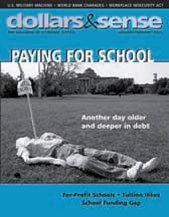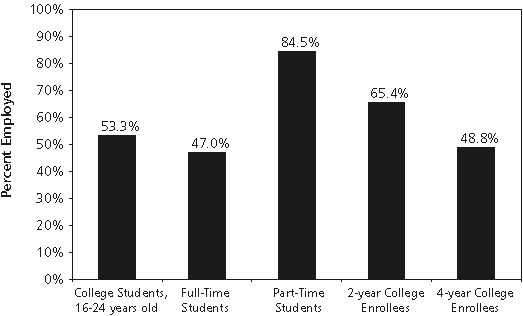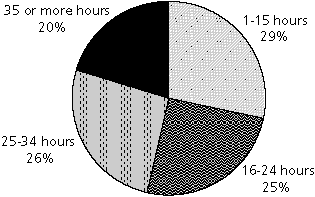Class Conflict
Tuition hikes leave college students in debt and torn between paid work and coursework.
This article is from the January/February 2003 issue of Dollars and Sense: The Magazine of Economic Justice available at http://www.dollarsandsense.org

This article is from the January/February 2003 issue of Dollars & Sense magazine.
Subscribe Now
at a discount.
Brigit M. just graduated from a public college in southern New Jersey with a 4.0 GPA. Putting herself through college with a full course load, she worked 25 to 30 hours a week off campus as a waitress, plus 8 to 12 hours a week on campus as a writing and economics tutor. She had a scholarship, but, as she says, "You think a full scholarship is great, but it doesn't cover books, transportation, and health care costs." She was lucky to have a flexible employer who was willing to accommodate her course schedule. But the time juggle was still difficult: "It was hard to come home from work at 11:00 p.m. and still have to write a paper that was due for an 8:30 a.m. class."
Brigit is one of almost six million working students in the United States. Many of these students do much more than put in a few hours in the school cafeteria or library. They cannot afford a college education without working long hours at one or more off-campus jobs, taking on heavy student loans, and using credit cards to fill in the gaps. The costs of college have skyrocketed, increasing faster than inflation, family incomes, and taxpayer funding of public institutions and financial aid programs. Full-time annual tuition now ranges from an average of $1,627 for a public community college to $15,380 on average for a private college or university. Total costs—including books and fees—are much higher. The total cost of attending a public community college on a full-time basis averages $7,265 a year, while a four-year public university averages $10,889, and a private college or university typically costs $19,443. Today's college students face tremendous monetary pressures.
Many Americans believe in education as a way of ensuring economic opportunity. Politicians and business leaders trumpet college education as means out of poverty, a by-your-own-bootstraps way of attaining the American Dream. Yet college is becoming less and less affordable, especially for students from lower-income families. Tuition at public and private institutions is rising faster than most families' incomes, according to a 2002 study by the National Center for Public Policy and Higher Education. Consequently, families paying college tuition today are shelling out much larger percentages of their incomes than families did twenty years ago. In 1980, the poorest one-fifth, or quintile, of Americans could pay tuition at a public two-year college with only 6% of their family income. By 2000, this percentage had doubled to 12% percent of family income. Four-year colleges and universities, including public-sector ones, take an even bigger bite out of tight family budgets. Tuition at a private college represents 25% of the annual income of the poorest quintile of families—up from 13% in 1980. It is not only the poorest families that are losing ground. Middle-class incomes have also failed to keep pace with rising tuition. Only the wealthiest families, those in the top income quintile—who since the 1980s have benefited from inflated stock prices, as well as tax cuts and other economic policies skewed toward the rich—have soaring incomes to match escalating tuition costs.
Why is tuition rising so fast? One reason is that colleges and universities are receiving less funding of other kinds; tuition is replacing other revenue sources such as donations, grants, contracts, and perhaps most significantly, state government appropriations to public-sector institutions. In fact, state appropriations to public two-year colleges, four-year undergraduate schools with some graduate programs, and research universities actually fell between the 1988-89 and 1997-98 academic years, and stayed level for four-year bachelor's institutions. The anti-tax, anti-government, anti-public services rhetoric and policies of the past few decades have undermined states' financial support for public institutions of higher learning. Yet these are the institutions with the explicit mission of making college accessible to all. The short-sighted mentality of "tax cuts today" has eroded our nation's public investment in human capital, much as it has our public infrastructure of roads, schools, and bridges.
Students Working Overtime
The gap between total costs and aid for full-time students is significant, averaging $5,631 a year at public community colleges and $6,904 at public four-year institutions. For students attending private colleges and universities, the gap is over $10,000.
More and more, students make up this shortfall with paid work. Almost three-fourths of all full-time college students work while attending school, reports the U.S. Department of Education in its 1999-2000 National Postsecondary Student Aid Survey (NPSAS). This figure is up four percentage points since the 1995-96 survey, and accounts for both on- and off-campus jobs, as well as work-study positions. While we might expect to see older, non-traditional students working, the U.S. Bureau of Labor Statistics reports high rates of employment even among traditional-age college students (those between 16 and 24 years old). These are the students we would most expect to receive parental support so that they could focus on classes and social life. But over half of these college students were holding down jobs (see Figure 1). Even young people who are full-time students and those enrolled in four-year colleges are employed at high rates, 47.0% and 48.8% respectively. For part-time students, employment rates are substantially higher, at 84.5%. Is this because working people choose to attend college on a part-time basis? Or because the costs of college require so many work hours that students cannot take a full-time course load?
Figure 1
Rates of Employment Among College Students 16-24 Years Old, October 2001

Source: U.S. Bureau of Labor Statistics, "College Enrollment and Work Activity of 2001 High School Graduates," News Release USDL 02-288.
Students' work hours indicate that they are paying for more than an occasional pizza in the dorm. Some 71% of full-time students who work are putting in more than the 15 hours per week one might expect of an on-campus work-study job, according to a summary of the NPSAS findings by the State Public Interest Research Groups' (PIRGs) Higher Education Project (see Figure 2). One out of five of these students working over 15 hours per week holds down the equivalent of a full-time job—balancing 35 or more weekly hours of paid work against a full-time course load.
Figure 2
Distribution of Full-Time Students Who Work, by Hours Worked per Week, 1999-2000

Source: Tracey King and Ellynne Bannon, At What Cost? The Price That Working Students Pay For A College Education, The State PIRGs' Higher Education Project, 2002.
Horace K. is a senior majoring in business, a member of the Student Senate, and a prominent student leader on campus. He works 14 hours a week between Sunday and Wednesday at his campus Student Development office. He has another 15- to 20-hour job at the local mall on Fridays, Saturdays, and Sundays. Saturday he is at the mall all day, then Sunday he follows his shift at the mall with a night shift at his on-campus job. Horace points out, "If I don't work, there's no way to buy books, food, and things of that nature." He feels lucky to have these jobs. After his first year, he was told he no longer qualified for work-study jobs because his father earned "too much." He could not find an on-campus job, there was no bus to the mall, and he did not have a car. His summer jobs paid for a car so he could commute to the mall.
While many students report educational benefits from their experiences in the work world, they also say that working has negative impacts on their grades, library access, class choices, and ability to get help with course work. For example, Auliya A., a first-year student, was told she had to attend an all-day orientation for her new job at an Atlantic City casino, forcing her to choose between employment and a quiz in one of her classes. Persistence in college studies, especially rates of completion, tend to be lower among students working full-time. One out of five first-year students working 35 or more weekly hours did not finish the school year, compared with only one out of 17 students working fewer than 15 hours per week. According to the PIRG study, the longer a student's weekly work hours, the lower the benefits and the higher the drawbacks they report. The conclusion of the PIRG findings seems to be that a moderate amount of paid work (less than 16 hours per week) yields a positive engagement with the world, but that long work hours harm academic achievement and students' overall college experience.
Of course, students from families with annual incomes of less than $20,000 are more likely to work, and to work longer hours, than those with family incomes of $100,000 or more. These students cite necessities such as tuition, fees, or living expenses as the primary reason for working, while well-off students work for spending money and job experience. According to the PIRG report, half of low-income students who work indicate that they could not afford to continue their studies without a job. Almost one-third (32%) of students from low-income families said that their grades suffered because of their paid jobs, while 23% of students from wealthy families voiced the same concern.
Increasing Debt Burden
The same students who are working long hours to pay their rising tuition bills are likely to rely on financial aid. Indeed, seven out of ten full-time students receive financial aid. Unfortunately, financial aid does not help as much as it once did. Pell grants are the most important needs-based aid program for low-income college students. Growing out of the War on Poverty and Great Society initiatives of the 1960s, federal Pell grants were created in 1972 as the core program for low-income and working-class college students. Grant aid per student, though, has not kept pace with the rate of tuition increases. Consider how far a Pell grant stretches. The maximum Pell grant of $4,000 represents only 39% of the average cost of attending a four-year public institution. Back in 1975-76, by contrast, the maximum Pell grant was equivalent to 84% of that cost. Grant aid programs originally reflected a vision that higher education should be accessible to all students, but today Congress is undermining that vision by allowing funding to erode.
As grant programs have become stingier, student loans (including federally guaranteed loans) have come to comprise a greater portion of financial aid. Because she worked so many hours, Brigit managed to graduate with only around $5,000 of debt. But this is far less than average. Various studies estimate that average student debt upon completion of a four-year degree falls between $12,000 and $19,000, depending on research methodology. Students are graduating from college shouldering more than a gown: their monthly debt payments typically amount to $150 to $200, and last for 10 years.
At least student loans have reasonable interest rates. That makes them quite different from the high-interest credit card debts many students pile up. Credit card companies aggressively market their wares to college students they know are struggling to make ends meet. Issuers customize their standards for college students, lowering or eliminating experience ratings and income requirements. "When you're a freshman," explains Horace, "you apply and you can get any kind of credit you want." Concern about aggressive marketing to students who may not understand the implications of carrying debt has led some universities to put limits on how their students can be solicited. Nonetheless, approximately two-thirds of college students have at least one credit card; these students carry an average balance of $2,748, according to one study reported by the General Accounting Office. Approximately 15% of students with cards have balances over $1,000. The degree to which students use their cards for direct college costs is hard to pin down. The GAO found studies indicating that as many as 21% of card users paid tuition with their cards and 7% used them for room and board.
Horace's story is instructive. He is graduating with $17,000 in debt from a series of government-subsidized and unsubsidized loans. None of his financial aid was grant aid. At one time, he also had $6,000 in credit card debt. During his first year, he says, he would "walk down the hallways, sign up for a card, and get free t-shirts." Enticed by the aggressive marketing, he wound up with six cards that he used to pay for tuition and books until he found steady employment. He has gradually paid off four of the cards, but still owes $2,000 between two of them.
Society's Costs and Benefits
There is a silver lining for students who struggle with course work and paid work, tuition bills and credit card bills. A college education brings tremendous benefits—both tangible economic gains and personal growth. College, as most students today recognize, is an "investment good," and the economic returns are substantial. The U.S. Census Bureau found that in 2000, college graduates earned 80% more than people with a high school diploma. As the U.S. economy has shifted from a manufacturing base, where jobs requiring only a high school diploma were plentiful, to a high-tech, "information-based" service economy, the demand for college graduates has escalated. Of course, the service economy also involves plenty of jobs in sectors like retail and food service. But even when a college degree is unnecessary for explicit job content, employers increasingly use it as a screening device to identify workers who they think will be hard-working and obedient.
So going to college is a little like buying a house: those who can afford the up-front costs reap great financial rewards later. This economic reality has boosted college enrollments despite the financial difficulties. The college enrollment rate of graduating high school students has risen for several decades, peaking in 1997 at 67%. There was a slight reversal as the rate fell to 63% for the high school class of 2000.
The market, however, now has the upper hand in determining who will have access to higher education. Both the federal government and the states have been shifting their responsibility for providing adequate resources for higher education to the private sector and students themselves. Markets allow the well-to-do to pay for tutors, college preparatory courses, and private college education for their children, who go on to keep the so-called "family tradition," while working-class and poorer students are more likely to be excluded from educational opportunities that can transform their lives.
Treating higher education like any other commodity to be distributed by market forces is a dangerous approach. Even the most narrow-minded economists agree that improving access to education generates benefits for society as a whole—it produces what economists call "positive externalities." Better access to education creates higher levels of skill and knowledge in the workforce, for instance. It also allows for the fuller use of one of our most valuable economic resources—our youth.
But restricting access to higher education is wrong for reasons much deeper than the fact that it "underutilizes" people. Education offers people an opportunity to expand their interests, understand human relationships, and develop a moral compass—it is not just job training, but a basis of human development. As Stanford education professor and feminist economist Myra Strober notes, economic theory is "ill suited to convey the complex and transformational goals" of education. It also fails to identify what is really wrong with leaving access to the market: education and development should be for everyone, not just those who can pay.
Viewed from this perspective, access to education should be considered a basic social right due to all people, like health care, child care, and adequate income. In most other highly-industrialized countries, people expect their government to guarantee the opportunities and material support needed to live decently: it is part of government's public purpose to provide for social rights. Access to an affordable education is one of those rights—but one that is now threatened as rising costs collide with declining aid.
